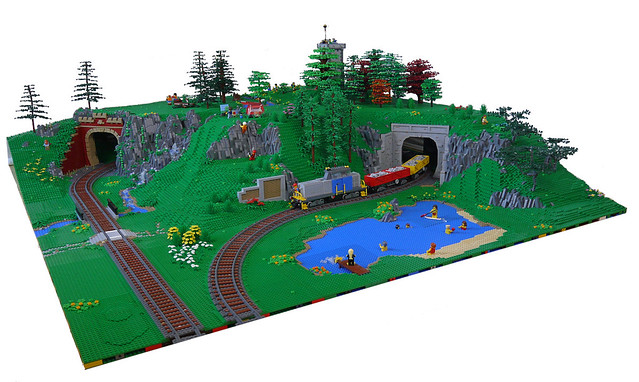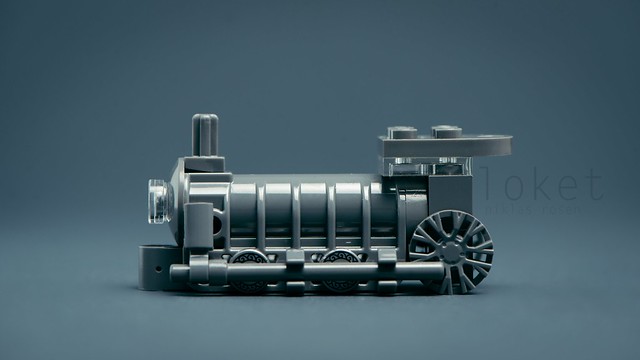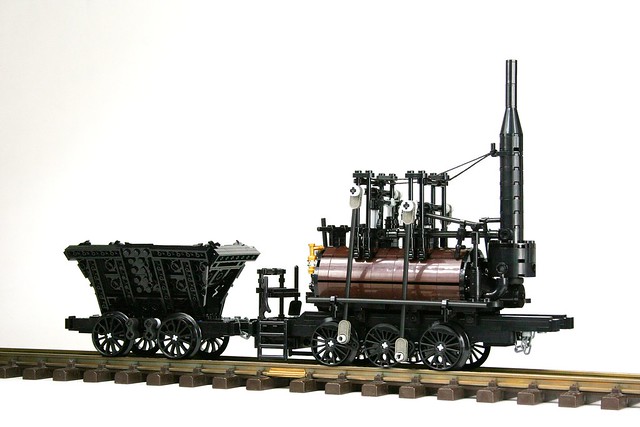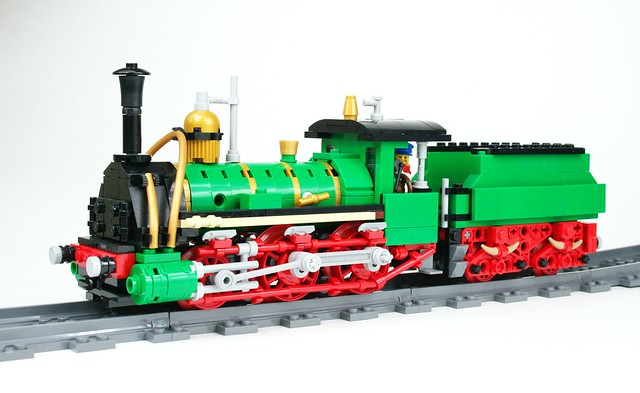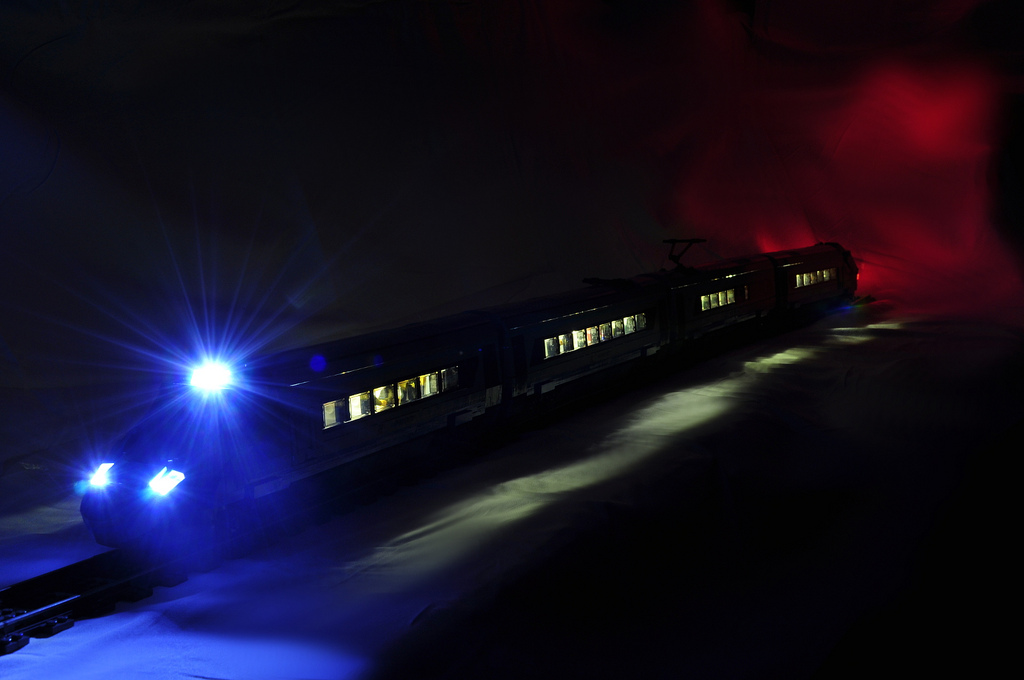I have a soft spot for collaborative LEGO train displays because they played a fundamental role in inspiring me to “build outside the box.” Because of this, I couldn’t help but smile when I saw Steffen Rau’s layout module. I love the curves of the track, mountainside tunnels, and wooded landscaping. It feels like a wonderful place to explore, especially with dozens of minifigures enjoying various camping activities.
Tag Archives: Train
Astounding LEGO Super Chief train up for charity auction [News]
The Super Chief was the flagship of the Santa Fe Railway. During the 30s and 40s it earned the nickname “The Train of the Stars” by hauling Hollywood celebrities from Chicago to Los Angeles, and becoming almost as famous as its passengers. Tony Sava has put together a formidable LEGO version of this iconic train, and has decided to auction it off for charity at Brickworld 2019 in Chicago. The 8-wide locomotive is a beast, beautifully detailed, fitted with Power Functions motors, and features smart custom stickers to recreate the Santa Fe livery. It’s a lovely model, and a lovely gesture for it to be donated to a charity auction — I hope it raises a caboose-load of cash.
The zombies are coming, so why aren’t you running?
I would not like to be the lone man with the dog in this latest build from Austrian builder Sanel Lukovic. With only his trusted canine companion and his guns, gear, and guts, things do not look hopeful with a ravening herd of mindless zombies pouring around every corner down the decrepit street. The decay and dereliction of the once bustling industrial sector is beautifully crafted, with exposed studs here and there showing how things have been slowly coming apart. Bits of various brownish hues sprinkled about create the appearance of rusted metal, while the overgrown vegetation tells us that no one with any brains has lived there for some time. So why has the lone figure returned to risk his noggin among such undead adversaries? We don’t know.
What we do know is that the scene itself is huge, with the sprawling rail yards and the broken street. I love the stacked shipping containers with partially opened doors using minifigure hands as handles, as well as the brick warehouse facade with cleverly arched windows. Sharp eyes will notice that the large spool for cables in the foreground is made from two Fabuland tables placed end-to-end. Some builders might disagree with me, but I also appreciate it when tiles are not fully pressed down to look like loose boards, like on the flatbed rail car. Careful details and creative parts usages abound throughout, making this a build that needs to looked at a few times to see everything.
A serene forest scene and a mighty steam engine
This scene of a steam train traveling through a forest by Allan Corbeil does so many things skillfully. Everything is executed wonderfully, but the centerpiece of the little diorama is clearly the steam engine in the middle. The train is perfect. My favourite aspects are the cloud of steam spewing forth from its chimney and the ingenious use of a Clikits ring on the front. While I love the train, it’s dwarfed by the magnificent beauty of nature that’s been recreated here.
The variety of vegetation–from tall coniferous and deciduous trees to the dense and varied underbrush–coupled with the pond make the whole scene seem real. The forest is so well done that I can almost smell the trees and hear water trickling. Maybe I might hear that train roaring down the tracks too. Be sure to check out Allan’s other pictures to get the same feeling I have, as well as spot a couple Easter eggs he included as surprises.
Train caboose takes me way back
LEGO trains have a big following in the LEGO fan community, and what follows LEGO trains? Well a LEGO caboose of course! In fact, one just like this cute little CN caboose by Mike Sinclair. This is a magnificent train car, but what makes it cute to me is that the model includes more than just rolling stock. Not every train car we see includes track and terrain, but it’s included here, and the green grass is the perfect complement to the red caboose.
In addition to the beauty and technical precision of this creation, I find it incredibly nostalgic. One on hand, the door is one that hasn’t been produced since 1980 and was a mainstay of the hand-me-down LEGO that started my collection. More than the bricks it’s made out of though, this little train car brings back memories of playing in a caboose at my local municipal museum as a child. I can fondly remember waiting to climb up in cupola and breathing in the smell of creosote railroad ties.
The little gray engine that could
Trains are complicated machines, especially steam-powered locomotives, which are a blend of smooth metal curves and a myriad of moving parts. Capturing this magical combination of sleek and mechanical details at a small scale can come down to a single part choice, and Niklas Rosén has really done it with his micro-model built around this Technic spring-loaded shooter. The curved lines along the side are reminiscent of riveted sections on the boiler. Meanwhile, the creation is finished off with a pair of driving wheels represented by hubcaps from the Speed Champions theme, and the smaller wheels are represented by printed 1×1 round tiles.
Riding the rails like it’s 1815
It’s hard to believe, but trains are now more than 200 years old, going back to the early 1800s for the most rudimentary steam-powered rail engines. This model by Nikolaus Löwe shows one of the first such engines constructed, which hails from 1815 and was known as the “Steam Elephant” due to its large trunk-like smokestack mounted on the front. Nikolaus has done an excellent job recreating the lattice of ironwork with bars and clips surrounding the boiler. Interestingly, he’s chosen to photograph it on a brass model track, which although not LEGO does look mighty nice.
All aboard the Victorian Railways from Melbourne to Sydney
Back in the early 20th century, the Victorian Railways in Australia ran two S class steam locomotives, first without streamlining and later with streamlined Art Deco styling. Australian LEGO train builders Alexander and Teunis Davey have collaborated to build both versions of these vintage trains. The earlier version looks beautiful in dark red with black details, while the later streamlined version looks fantastic in dark blue and gold.
Alexander users a number of custom elements in the locomotives, including 3D-printed rods and valve gear, as well as the gold locomotive names and trim. As much as I love the Art Deco look of the 1937 train, I’m smitten with the classic look of the original, unstreamlined locomotive.
What’s green and gold and red all over?
If there’s one thing I can say about Nikolaus Löwe, it’s that his last name rhymes with “wow!” We were certainly “wowed” by Nikolaus’ steam traction engines back in February and are happy to see he’s keeping the steam dream alive with this handsome locomotive. According to Nikolaus, it is modeled after a steam engine that was built in 1875. The way the green body with gold trim rests atop the red undercarriage is eye-pleasing. Speaking of the undercarriage, it sports some serious detailing that would look stunning on its own, including the use of 3D-printed elements for some of the rods. Now that’s the hallmark of an engineer!
Alstom Pendolino ED250 PKP Intercity built from LEGO
I always find myself amazed with LEGO train builders’ ability to translate feats of human engineering, into feats of LEGO engineering, and this beautiful Alstom Pendolino ED250 by Mateusz Waldowski is no exception. For those curious about the name, Alstom is the manufacturer, and ED250 PKP is the actual model of train. Pendolino designates this train as part of a family of “tilting trains”, trains that tilt into a curve so they can go around at a higher speed, without causing passenger discomfort.
Mateusz has done an excellent job achieving the slightly sloped sides of the passenger cars, along with the round nose of the engine, which can be the most difficult part of building a modern train. There’s also something satisfying about the red flex tube used on the electrical contact rollers, its a small detail but it provides a nice spot of color. In addition, as if the expert construction wasn’t enough, the builder also seamlessly incorporated interior lighting on the passenger cars and exterior lights on both the front and rear locomotives.
If you’d like to see more of Mateusz’s excellent builds, check out the links below:
Newag 15D/16D Cargo Locomotive
1977 Granada MK1 Station Wagon
To the moon, with steam!
I’m not quite sure how the mechanics of a steam-based industry work on the moon, or how exactly a lighter-than-air vehicle like a zeppelin would float above an airless surface, but Dwalin Forkbeard certainly makes such a fantastical idea believable with this steampunk city on the moon.
Rob Winner builds a winner of an engine shed
I’m a sucker for history and trains, and Rob Winner delivers on both counts with this slice of the Illinois Midland Railway in LEGO-form. According to the builder, the real line was only 1.9 miles long. This was in large part because of a crooked businessman making big promises and running off with the community of Newark’s money. Regardless, the little town made use of the railway to connect with nearby Millington. Rob’s model is meant to represent the railway during the 1940s, back when World War I veteran William Thorsen was running the show. Thorsen is depicted with the vehicles he operated, including a Vulcan 0-4-0T steam engine and Ford Model T railway inspection car.
The engine shed plays its part well, looking weathered and forgotten. Rob pulled this off by adding vines and slightly tilting brown plates outward to simulate loosened wooden boards. It’s a stark contrast to Thorsen standing among railway equipment that looks well taken care of. Then again, he is their devoted caretaker! This juxtaposition is inspiring, symbolizing the fight to persevere against all odds.
